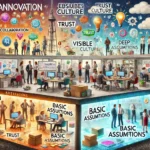Mikh Podcast – Episode 1: The Challenges of Change Management in Organizations
In this episode, we’re diving into a topic that might seem simple at first glance, but once you get into it, you realize it’s full of complexities—the challenges of managing change in organizations.
Why is change in organizations so difficult?
Why do some people resist it?
And more importantly, how should leaders and managers navigate these transitions?
If you’re working in an organization going through changes or if you’re a manager or entrepreneur dealing with transformation, stick around—this one’s for you.
Why is change so difficult in organizations?
Let’s start with the fundamental question: Why is change so hard in organizations?
One of the biggest reasons is that we, as humans, are wired for stability. Our brains are designed to fear the unknown. When something unfamiliar enters our space, our minds send warning signals:
“What if things get worse?”
Now, take this natural fear and put it in a workplace setting—it amplifies.
Why?
Because in organizations, change isn’t just about learning something new; it’s about job security, income, and even professional identity.
Imagine a manager announces:
“We’re going to digitize our workflows.”
Some employees might instantly think:
“What if I can’t keep up? What if I lose my job?”
Let’s take a simple example.
Say you’re running a sales team, and you decide to switch from traditional pen-and-paper processes to an advanced CRM (Customer Relationship Management) system. Instead of excitement, you might find your team feeling anxious.
Why?
Because they don’t understand the software, they fear they won’t be able to adapt, and ultimately, they worry that their performance will drop.
The biggest challenge: Employee resistance
One of the greatest hurdles in change management is resistance from employees.
Where does this resistance come from?
- Fear of the unknown – Like the CRM example, people resist what they don’t understand. It makes them feel insecure and uncertain.
- Lack of trust – If employees don’t trust leadership, they will automatically be skeptical of any change.
- Feeling left out – When employees feel that change is happening to them instead of with them, resistance grows.
Think about this:
If someone has been doing a job the same way for 10 years, suddenly changing their workflow feels like breaking a long-standing habit.
Here’s a real-life example:
A few years ago, a local bank decided to move all its services online. The goal was clear—make banking more convenient for customers. But the branch employees resisted.
Why?
Because they thought that if everything went digital, their roles would become obsolete.
But what happened?
The change didn’t replace them—it enhanced their roles.
How can leaders manage change more effectively?
If you’re a leader or manager, here’s what you need to do to make change easier for your team:
1. Clearly communicate the purpose of change
Your employees need to know why change is happening and how it affects both them and the organization.
For example, tell your sales team:
“This new CRM system is going to make your work easier and help you attract more customers effortlessly.”
2. Involve employees in the process
Instead of imposing change from the top down, bring your team into the conversation.
Say something like:
“Let’s brainstorm together—how can we make the implementation of this new software as smooth as possible?”
When people feel like they are part of the decision-making process, their resistance drops.
3. Provide training and support
Many times, employees resist change simply because they don’t know how to handle it.
A well-structured training program, tutorial videos, or even a simple guide can ease their concerns significantly.
4. Show them the personal benefits
Make it clear that embracing change can open doors for career growth and new opportunities.
For example, tell them:
“By learning this new system, you’re not only making your work easier, but you’re also increasing your chances for promotion.”
Change is a process, not an event
Change in organizations doesn’t happen overnight. It’s a continuous process.
At first, there will always be resistance. But with clear communication, employee involvement, and the right support, the transition can become much smoother.
What’s your experience?
Are you currently dealing with change in your organization?
I’d love to hear your thoughts, experiences, or even questions.
Drop a comment—I’m looking forward to your insights.
Remember, every change is a step toward growth. 😊









